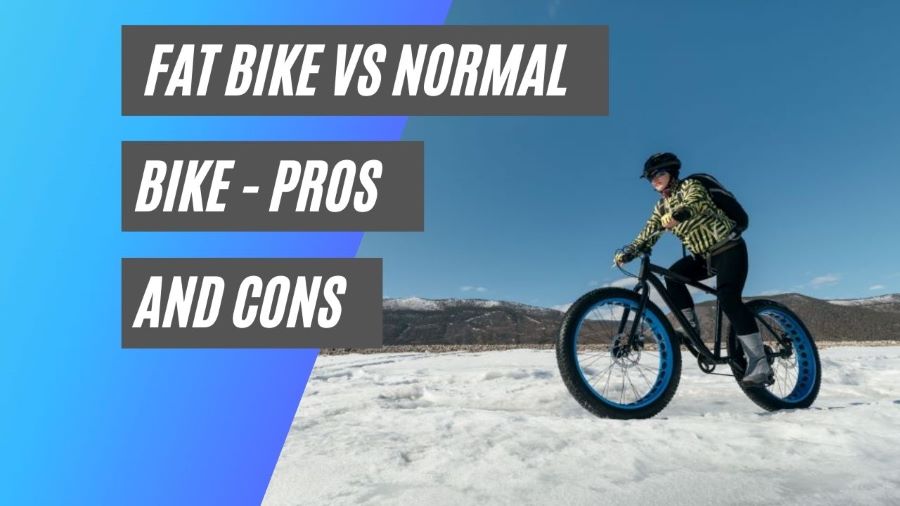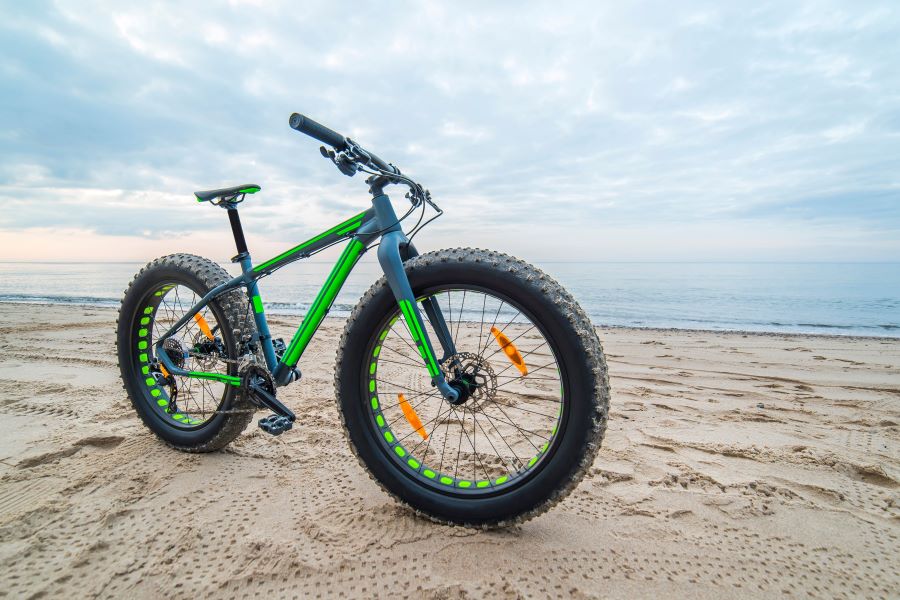This post may contain affiliate links. If you click an affiliate link and make a purchase, I may earn a commission. Also, as an Amazon Associate, I earn from qualifying purchases.--
A fat bike is essentially a mountain bike on steroids.
The fat bike is distinguished by its wider tires, which range from three to five inches in width. If you reside in a snowy/icy/cold area, the fat bike outperforms the “normal” bike in terms of value.
In this article, I’m going to look at exactly what a fat bike and a ‘normal’ bike are, and then dive into all the pros and cons of owning either. You can find out which is better for you based on:
- Where you live
- The terrain you’re going to be riding over
- Your budget
- Ongoing maintenance
- What you want the bike for

What Is A Fat Bike?
I’ll start by explaining everything there is to know about fat bikes.
It is currently one of the most famous bicycle variations, and it has grown in popularity quickly. Its one-of-a-kind design and contemporary aesthetics have made it a popular choice among riders.
Its massively inflated tires will entice you just by looking at them.
A fat bike is an off-road bicycle that has extra-wide tires that are often 3.8″ (96mm) or wider, as well as 2.6″ (66mm) or wider rims.
To accommodate the broad tires, the frame, fork, and wheels have been explicitly constructed. The air pressure in fat bike tires is usually kept low, between 5 and 14 psi.
On the other hand, these tires aren’t just for show; they have a specific purpose. The broad tires’ goal is to spread the bike’s and rider’s weight over a larger surface area than standard bike tires.
This lowers ground pressure, allowing you to float over soft or unstable terrain where regular mountain bike tires might sink in and become stuck.
These big wheels are custom fitted to the bikes to allow them to access areas where riding usually is impossible. If you live near the shore, you should consider acquiring one of these because the tires provide a smooth ride in the desert or on snow.
Another advantage of owning a fat bike is that it is a wonderful way to get a speedy workout.
Because of its substantial weight and large wheels, riding a fat bike demands more energy. As a result, riding this bicycle around your neighborhood will allow you to quickly work up a sweat.
As an added plus, it helps you stand out!
For off-road riding and bike packing, fat bikes are becoming a popular alternative to mountain bikes.
They’re entertaining, one-of-a-kind, and allow you to ride in locations where no other bike can, such as heavy snow and loose sand.
What Is A “Normal” Bike?
The most popular type of bike on the market is the mountain bike. I am going to refer to mountain bikes as the ‘normal’ bike for the rest of this article.
Mountain bikes have a storied history among cyclists.
No other version has amassed such a devoted following as this one. Since the 1980s, it has been one of the most popular bicycles.
Its outstanding longevity combined with its ability to operate in every terrain has made it extremely popular to this day.
For people who enjoy riding in the countryside or on tough terrain, a conventional mountain bike is ideal.
It can instantly adapt to difficult conditions and provide you with a memorable experience. Its wheels also have good traction, allowing you to maintain control and reducing the risk of an accident.
The mountain bike’s brake system is another fantastic feature. For a sharp handling experience, these bikes should have hydraulic disc brakes.
It’s a foregone conclusion that you’ll want to ride this bicycle off-road, so you’ll need complete control.
Let’s take a look at all the pros and cons of owning either a fat bike or a normal bike:
Pros of Fat Bikes
You Can Ride Fat Bikes in Heavy Snow, Loose Sand, and Muck
Because the broad tires spread your weight, the bike, and your gear across a larger surface area, this is possible.
The ground is less impacted by the fat tires. This helps the tires to roll over the snow, sand, and mud rather than sinking down and becoming stuck as a traditional mountain bike tire would.
Flotation is a term used to describe this rollover phenomenon.
Furthermore, the extra-wide tires offer a bigger contact patch with the ground, resulting in exceptional traction on slick snow, ice, and sand.
When you hit a slick area, the fat bike won’t slide out from under you.
You Can Have a Comfortable and Relaxing Ride
Low air pressure is possible with the big capacity fat tires.
The tires become extremely soft as a result. Shocks and vibrations from the road or path are absorbed by soft tires. Instead of bouncing off a rock in the trail, the tire deforms around it and absorbs the impact.
Because you’re not bouncing about as much, this enhances comfort and lowers fatigue while riding through tough terrain.
On a fat bike, the ride is significantly smoother. Some fat bikes have a suspension fork to improve the ride quality even more.
Furthermore, most fat bikes’ frame shape provides a comfortable upright riding stance. The back, neck, and shoulders are not overworked as a result of this.
Exceptional Traction and Grip
The wider, higher-volume fat tires have a greater contact patch with the ground than mountain bike tires with a narrower contact patch.
The tire’s friction with the ground is increased; this improves traction. You may also run fat tires at 5-8 psi, which is quite low.
This softens the tire, allowing more tread to contact the ground. Resultantly, you’ll gain even more traction.
When riding in slippery conditions like snow, ice, sand, or wet rocks, extra traction is vital. Increased traction also helps you to corner, accelerate, and brake more aggressively without your tires slipping.

Cons of Fat Bikes
Replacement Parts Can Be Difficult To Find
Fat bikes have tires, rims, hubs, bottom brackets, and cranks that are not normal in size.
You might have problems finding replacements if any of these parts fail or get damaged. Fat bike parts aren’t readily available in many bike shops.
This is especially true if you’re bike touring or bikepacking in a developing country or remote area. If you shatter a rim or destroy a tire when riding through the Andes, for example, you may need to go to the nearest capital city to get the parts you require.
Fat bike parts might be tough to come by even in impoverished countries. You may need to buy your parts online if you live in a small town or rural location.
Fat Bikes Weigh a Lot
The extra-wide tires and rims are made of more material, thus, they are heavier.
A typical mid-range fat bike weighs between 33 and 40 pounds.
Fat bikes with carbon fiber frames are the lightest; weighing roughly 30 pounds.
A typical mountain bike weighs roughly 30 pounds, with the lightest ones averaging around 22 pounds. The increased weight affects efficiency and makes riding more difficult.
Fat Bikes Are Slow and Accelerate Inefficiently
The additional rolling resistance caused by the broad, low-pressure tires significantly slows you down, especially when cycling on the road.
When riding a fat bike, you won’t be able to accelerate as quickly and will only be able to maintain a lower average speed.
In order to cover the same ground as a mountain bike, you’ll have to spend more time in the saddle.
Pros of ‘Normal’ Bikes
Their Parts Are Readily Available
Mountain bikes are one of the most popular bicycle variants worldwide.
You can nearly always find a spare tire or tube wherever you are. Finding a rim or perhaps a full wheel will not be difficult in most parts of the world.
The availability of the spare parts depends on the wheel size you choose and where you ride.
26″ wheel parts are more common in underdeveloped countries, while 700c wheel parts are more common in developed countries. Parts for fat bikes aren’t easy to come by.
More Affordable
Mountain bikes are offered in a variety of price ranges. Good mid-range models cost between $1000-$1800. (Source)
For just over $100, you can get an inexpensive entry-level one from a big box store like Walmart. Mountain bikes that have been used are also easily available and are favored among bikers.
You can get a fantastic mid-range mountain bike for $200-$300 if you keep a watch on places like Craigslist or Facebook Marketplace.
A low-cost fat bike will set you back roughly $500, while a mid-range one would set you back around $2,000.
They Weigh Less
Mountain bike tires and rims are much narrower and require far less material to manufacture. They become lighter as a result.
A mountain bike is about 5-10 pounds lighter than a fat bike of the same size.
A lightweight bike is more agile, faster, and efficient.
Cons of Mountain Bikes
Some Types of Terrain Are Impossible To Ride on a Mountain Bike
Mountain bikes have a hard time handling sand, snow, or thick mud because their tires sink in. When this happens, pedaling becomes nearly impossible.
On slick surfaces, the bike may slip.
Large pebbles on the ground might make it tough to negotiate with a mountain bike.
The Ride Is Rougher
Because mountain bike tires have a lower capacity and run at higher air pressures, they don’t absorb shocks and vibrations as well as fat bike tires.
Shock is absorbed by your body instead when you encounter a large bump or rock on the trail.
Many mountain bikes, of course, include rear suspension to help level out the bumps.
The Wheel Gets Damaged Easier
Mountain bike wheels are structurally weaker than fat bike wheels because they have a bigger diameter (typically 29″) and are narrower.
They have longer spokes, which are more likely to flex or break. Under tension, the rims can potentially twist or shatter.
The Differences between a Mountain Bike and a Fat Bike
The breadth of the tires is the meaningful difference between a fat bike and a mountain bike.
The width of fat bike tires ranges from 3.8″ to 5.2″. (96-132mm). Standard mountain bike tires are between 1.9″ and 2.6″ wide (48-66mm).
Fat bikes require bigger rims than mountain bikes to accommodate such huge tires.
Rims for fat bikes are 55mm or wider, with 65mm being the most popular.
Most mountain bike rims are 30mm wide.
The diameter of fat bike rims is 26″ or 27.5″. The wheels have a diameter of the 29″ wheels found on modern mountain bikes thanks to the high-volume tires.
Another significant distinction between fat bikes and mountain bikes is the tire pressure.
The pressure of fat bike tires can be as low as 5-14 psi (.34-.97 bar). Most riders run their mountain bike tires at 22-25 psi as a comparison (1.5-2.4 bar). This is feasible because fat tires are so voluminous that if you strike an obstruction, they won’t bottom out and strike the rim.
Conclusion
Fat bikes can traverse terrain that no other bike can. A fat bike, for example, can easily handle thick sand, snow, and mud. Fat bikes can also tackle uneven surfaces such as rocks, dips, bumps, roots, potholes, etc.
This is feasible thanks to the extra-wide fat bike tires, which disperse the bike’s and rider’s weight over a larger surface area. This enables the tires from sinking in and the bike from getting stuck.
